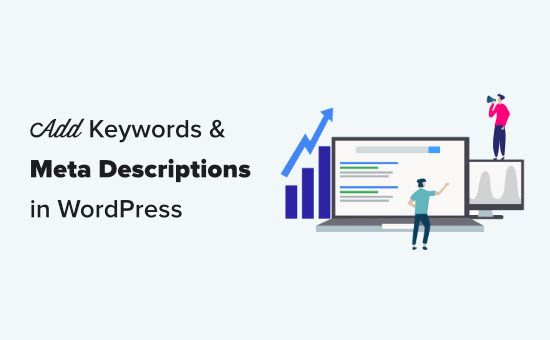Keywords and Meta Descriptions in WordPress

Keywords and Meta Descriptions; Keywords make a difference on search engine results pages (SERPs). That’s why it’s crucial to the success of your site to understand how to add keywords to WordPress. Although they are almost identical, one word is different. This word, or keyword, refines the search parameters. Therefore, the first search will return results that provide information on website building tools and technologies, while the second will offer suggestions to help solve specific problems.
This means that for your WordPress site to stand out, you need to identify relevant keywords and effectively incorporate them into your content. Then, when your target audience searches, your site (ideally) appears on the first page of search results. What are keywords and why are they important in WordPress?
They succinctly describe what your site or service is about and are used by search engines to find the most relevant results for user queries. For example, if you own a window cleaning business in Chicago, you’ll want to use keywords like “window cleaning services Chicago,” “window cleaning and Chicago,” and “window cleaning Chicago.
Since the most basic relevance signal is a web page that contains the same keywords used in the search query, search engines like Google look for keywords in the URL, meta description, title, headings, text Alternate image, and body text. Geographic location is also important; search engines prefer to provide local results whenever possible.
Keywords
Keywords are words and phrases, relevant to your blog content, that makes your site appear when people search for those terms. Using relevant keywords can dramatically improve your search rankings. A meta description is a brief description of a website or page. It allows you to have a clear and concise description that appears in the search results. Without it, Google will simply extract the text from the website. Although these attributes may seem small, they can make a big difference in your SEO ranking. Fortunately, it is quite easy to edit them in WordPress. This guide will walk you through the two methods available to add keywords and descriptions: download a plugin or add them yourself.
First method: Yoast SEO
By far the easiest way to add keywords and meta descriptions in WordPress is to use the Yoast SEO plugin. This tool is designed to get you to the top of the search rankings, and it’s very easy to edit things like titles and meta descriptions with it. As of Yoast version 6.3, you can no longer add meta keywords to your posts and pages. However, you can still add a focus keyword, which is a word or phrase that best defines your article. By placing this keyword naturally on your page, it will rank higher. Yoast helps you include these specific keywords in your article.
To add meta attributes to your website with a plugin, you will need to follow these steps.
1. Install and activate the Yoast SEO plugin
2. Add a specific keyword
3. Add a meta description
Second Method: By hand
Maybe you’re a big believer in meta keywords or just prefer to do things yourself. In any case, it is possible to add important meta attributes to WordPress without using plugins. To do this, you just need to follow these few steps. 1. Edit your header.php file 2. Add a conditional tag query for individual posts and pages
Install and Activate Yoast SEO Plugin
To install Yoast SEO, you can get it from your admin dashboard, WordPress repository, or Yoast website. If for some reason you need to install Yoast manually, try this guide to update plugins via FTP.
Add a focus keyword
Whatever post, category, or page you want to edit, head over to your WP-Admin and find it on the left side. If you want to edit a post’s keyword or meta description, for example, click Posts » All Posts and select one! Now that Yoast SEO is installed, you should see a box at the bottom of the page, below your post content. You can set your priority keyword in the “Keyword” tab. Once you do, Yoast will make edit suggestions, such as including that keyword in your H2 captions.
Follow them and your search ranking will improve soon! Yoast no longer supports meta keywords because many search engines ignore or don’t prioritize them due to abuse, so you’ll have to add them manually if you want.
Add meta description
On the same “Keyword” tab, you should see a preview of how your article will appear on Google. Here you can edit your page title and meta description. Use it to write a concise, readable paragraph that includes useful and relevant keywords.
Think of it as a pitch. Your job is to convince anyone who sees your result on Google to click through and check it out! And that’s how you add targeted keywords and meta descriptions using Yoast SEO.
The Good – Keywords
The first result on Google gets 31.7% of all clicks, while the second-page results only get 0.78% of all clicks. This is the difference applying SEO best practices can make to your content, and therefore your business. Keypads and meta descriptions are the small parts of SEO that can help you rank your web pages higher in search engine results pages (SERPs), and the higher the ranking, the better for your business. . They provide additional information to search engines and use your content. When Google knows exactly what your content is about, your chances of showing your article to users who want to know more about a specific keyword are higher.
More views translate to more traffic and ultimately more sales and conversions. You can also use SEO plugins to add meta descriptions and keywords designed to optimize content and honestly, they are amazing. Especially for WordPress, help expand the scope of the source software with special tasks and functions that usually affect crucial aspects like SEO, online marketing, and web analytics. In other words, it makes optimizing your website content easier and more efficient. Not to mention very fast too.
Bad – Keywords
You really can’t be sure how much weight search engines give to keywords and meta descriptions. There is general disagreement among WordPress experts on whether keywords and meta descriptions are really important to improve your rankings or just extra work that isn’t worth it.
Also, although Yoast SEO is one of the best plugins to optimize content, it does not give you the option to add meta keywords.
This main task is to inform search engines in more detail about the subject of the page. If you want to add meta keywords to a web page, you’ll need to do it manually, which can be a bit more complicated than just using a plugin. Another thing I want to bring to your attention is keyword stuffing.
Yoast SEO gives you suggestions to make your content more attractive to the SERPs, and that is undoubtedly amazing.
However, there are times when adding keywords, plus any suggested edits, to your content can take away from the natural flow and make it look forced and overly “optimized. So while optimization is great, it shouldn’t come at the expense of the flow and quality of your content.
What is the meta description?
A meta description in WordPress is a short piece of text that describes the content and purpose of a page. This snippet appears in the SERPs and helps users understand if the page meets their search intent without having to open it. WordPress allows you to customize meta descriptions for posts and pages. If you don’t add a meta description yourself, Google will automatically take snippets from the pages and generate a description for each one. While it may seem convenient to leave this task to Google, you may be missing out on an opportunity to drive traffic by writing a compelling meta description that is relevant to your audience.
How do meta descriptions work?
When users use search engines like Google, they get a results page that contains a list of content from various websites. They can see page titles, URLs, and meta descriptions as short paragraphs for each site. The search engine will search for all available meta descriptions for that particular page. If the search engine doesn’t find one, it will generate one on its own. If you have already written a meta description for a page, search engines will display that text on the results page.
However, this is not always the case. Search engines may find your meta description irrelevant to search keywords. In this case, search engines will always grab a snippet of the content. That is why it is essential to write a meta description that contains the specific and relevant keywords for the content. It should also be attractive and well-written enough to entice people to visit your site.
Why add WordPress meta description, meta title, and focus keyphrase?
According to WordPress, millions of blog posts are published every day, so you will have to face competition when trying to rank at the top of Google’s SERPs. The results on the first page of the SERP get 71.33% of the clicks and the top five get 67.60% of all those clicks.
This is why it is important to write the meta title and meta description, as well as incorporate a focus key phrase; this helps search engine crawlers know what type of content the page or post is about and whether they should rank it higher. Meta descriptions also give users first impressions of your website. They display information about the content they will find within, allowing you to decide whether or not your site will answer the search query.
To summarize, here are brief definitions of meta titles, meta descriptions, and target keyword phrases, and why they are an essential part of SEO strategies:
Meta Title:
The title of the page that appears in the SERP may differ from the actual name of the site. The title tag is an important aspect of on-site SEO because its wording can affect the click-through rate.
Meta Description:
The short snippet summarizes the content of the page. The meta description should be attractive and consistent as it should catch the reader’s attention at a glance.
Pay attention to search intent: Think about what drives users to search for a particular keyword to get the information they need.
Write your meta description in a way that explains how your website content answers your query.
Keep it short: don’t exceed 160 characters or Google will cut the snippet.
Include call-to-action words: If appropriate, use a call-to-action such as “learn more,” “save money,” or “get yours” in your meta description.
Avoid keyword stuffing: Don’t use keywords repetitively. Ideally, you should only include the target keyword phrase once.
Focus Keyphrase
The keywords you want to rank for. Use focus keyword phrases in your meta title and meta description in WordPress to improve SEO rankings.
Q&A
How do I edit SEO in WordPress?
To change the SEO title on your individual posts and pages, you need to scroll down to the AIOSEO Settings on the post or page you are editing. Just like when you change the SEO title for your home page, you can click on one of the smart tags or type your own SEO title.
Where are the SEO settings in WordPress?
Make sure the settings are off and everything will be great! This is probably the most important of all the essential WordPress SEO settings.
How many keywords should I use for SEO?
You’re much more likely to want to target two or three keywords per page, even if they’re close variations. With a given keyword range per page, we can estimate how many keywords we will track.
What is a meta description?
Meta Description is the main description overall from the paragraph. They are like a pitch that convinces the user that the page is exactly what they’re looking for. It should be more specific with the title.


